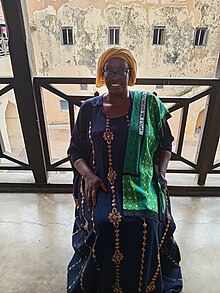
Swahili, also known by its local name Kiswahili, is a Bantu language originally spoken by the Swahili people, who are found primarily in Tanzania, Kenya and Mozambique. The number of current Swahili speakers, be they native or second-language speakers, is estimated to be over 200 million, with Tanzania known to have most of the native speakers.

Zanzibar is an insular semi-autonomous region which united with Tanganyika in 1964 to form the United Republic of Tanzania. It is an archipelago in the Indian Ocean, 25–50 km (16–31 mi) off the coast of the African mainland, and consists of many small islands and two large ones: Unguja and Pemba Island. The capital is Zanzibar City, located on the island of Unguja. Its historic centre, Stone Town, is a World Heritage Site.

As it is in other countries, the music in Tanzania is constantly undergoing changes, and varies by location, people, settings and occasion. The five music genres in Tanzania, as defined by BASATA are, ngoma, dansi, kwaya, and taarab, with bongo flava being added in 2001. Singeli has since the mid-2000s been an unofficial music of uswahilini, unplanned communities in Dar es Salaam, and is the newest mainstream genre since 2020.

Bao is a traditional mancala board game played in most of East Africa including Kenya, Rwanda, Tanzania, Comoros, Malawi, as well as some areas of DR Congo and Burundi. It is most popular among the Swahili people of Tanzania and Kenya; the name itself "Bao" is the Swahili word for "board" or "board game". In Tanzania, and especially Zanzibar, a "bao master" is held in high respect. In Malawi, a close variant of the game is known as Bawo, which is the Yao equivalent of the Swahili name.
Tanzanian Hip-hop, which is sometimes referred to Bongo Flava by many outside of Tanzania's hip hop community, encompasses a large variety of different sounds, but it is particularly known for heavy synth riffs and an incorporation of Tanzanian pop.

Bagamoyo is a historic coastal town and capital of Bagamoyo District in the Pwani Region of Tanzania. Much of the settlement was founded at the end of the 18th century, though it is an extension of a much older Swahili settlement, Kaole. It was chosen as the capital of German East Africa by the German colonial administration and it became one of the most important trading ports for the Germans along the East African coast along the west of the Indian Ocean in the late 19th and early 20th century. Bagamoyo lies 75 kilometres north of Dar-es-Salaam on the coast of the Zanzibar Channel, across from the island of Zanzibar. The town hosts Bagamoyo Historic Town, that is a National Historic Site of Tanzania. In 2011, the town had 82,578 inhabitants.
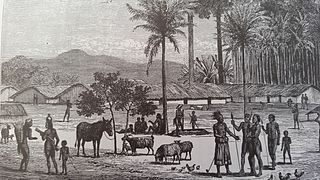
Manyema (WaManyema) (Una-Ma-Nyema, eaters of flesh) are a Bantu ethnic group, described in the past as powerful and warlike, in the African Great Lakes region of Eastern Africa and Central Africa.
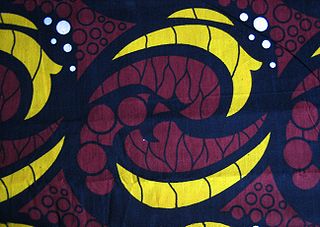
A kitenge or chitenge is an East African, West African and Central African piece of fabric similar to a sarong, often worn by women and wrapped around the chest or waist, over the head as a headscarf, or as a baby sling. Kitenges are made of colorful fabric that contains a variety of patterns and designs. In coastal areas of Kenya and in Tanzania, kitenges often have Swahili sayings written on them. There seems to be a confusion with the Kangas, which indeed carry texts in contrast with kitenges, which apparently typically do not carry texts.

Swahili culture is the culture of the Swahili people inhabiting the Swahili coast. This littoral area encompasses Tanzania, Kenya, and Mozambique, as well as the adjacent islands of Zanzibar and Comoros along with some parts of Malawi and the eastern part of Democratic Republic of Congo. They speak Swahili as their native language, which belongs to the Bantu language family. Graham Connah described Swahili culture as at least partially urban, mercantile, and literate.
Baraza la Kiswahili la Taifa is a Tanzanian institution responsible with regulating and promoting the Kiswahili language.
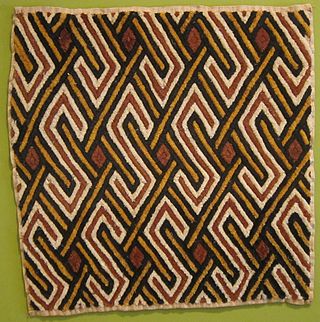
African textiles are textiles from various locations across the African continent. Across Africa, there are many distinctive styles, techniques, dyeing methods, and decorative and functional purposes. These textiles hold cultural significance and also have significance as historical documents of African design.

Siti binti Saad was a pioneering Tanzanian musician in the taarab musical style. Through her music she was also an anti-colonial activist, feminist and Swahili cultural icon of 20th century. She produced over 250 phonograph records throughout her lifetime, becoming the first East African vocalist to release commercial recordings in the 1920s and 1930s. She also added a brand-new dance and pantomime component to taarab music called "natiki," which was inspired by Indian dance. She was a trailblazer as a female performer in the genre during a time when men artists controlled the industry. She performed in a variety of languages, but most significantly in Swahili, in contrast to earlier vocalists who solely sang in Arabic. She sang in cities of the coast of Tanganyika and Zanzibar.
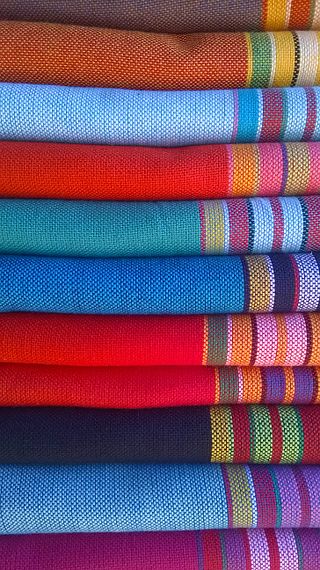
A kikoi is a traditional rectangle of woven cloth originating from Africa. Considered a part of Swahili culture, the kikoi is mostly worn by the coastal men but now includes the Maasai people of Kenya as well as men from Tanzania and Zanzibar. It is most commonly viewed a type of sarong.

The kofia is a brimless cylindrical cap with a flat crown, worn mainly by some men in East Africa.

Pangani is a historic town and capital of Pangani District in the Tanga Region of Tanzania. The town lies 45 km (28 mi) south of the city of Tanga, at the mouth of the Pangani River in which the town is named after. Administrately the town Pangani is situated within two wards, Pangani Mashariki and Pangani Magharibi. The town is currently the largest settlement in Pangani District and is a major tourist attraction in Tanga region and is a home to Muhembo, a Tanzanian National Historic Site.
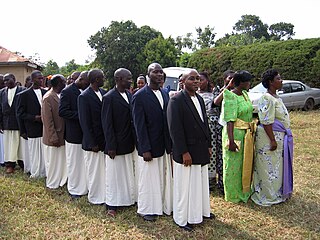
A kanzu is a white or cream coloured robe worn by men in the African Great Lakes region. It is referred to as a tunic in English, and as the Thawb in Arab countries. The kanzu is an ankle or floor length garment. It serves as the national costume of Tanzania as well as the Comoros, where it is called/pronounced 'Kandu' as well as thawb. The robe is also worn in some coastal Muslim regions of Tanzania and Kenya. The men of Uganda consider it their most important dress. Kanzu is a Ganda word of Swahili origin, which means "robe" or "tunic". In Tanzania, the term is used interchangeably with kaftan.
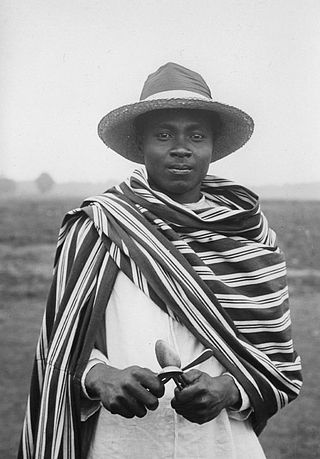
A lamba is the traditional garment worn by men and women that live in Madagascar. The textile, highly emblematic of Malagasy culture, consists of a rectangular length of cloth wrapped around the body.

Mathias E. Mnyampala (1917–1969) was a Tanzanian writer, lawyer, and poet. Mnyampala was born on 18 November according to a personal record form of 1956, but he wrote in his autobiography, Maisha ni kugharimia, that he only knew the year with accuracy. He was born in the hamlet of Muntundya depending on the village of Ihumwa in Chamwino District in Dodoma region at the time part of German East Africa. He died on 8 June 1969 in Dodoma city, Tanzania. Mnyampala wrote in Swahili, the lingua franca of East Africa, not Cigogo, the native language of his ethnic group.
Haji Gora Haji was a Swahili-language poet, lyricist, and writer from the Zanzibar archipelago. He channeled his expansive knowledge of the culture and society of the Swahili coast, especially his homeland of Tumbatu, into his works. For his work inspired by the seascape of his home, he has been called "The Old Typhoon". He worked in a multitude of forms, from songs, stories, and epics to a full-length novel. His compositions and verse were frequently on Tanzanian radio.

The Nairobi Gallery is an art gallery located an at the edge of the Nairobi central business district. The gallery is dedicated to showcasing African art.




